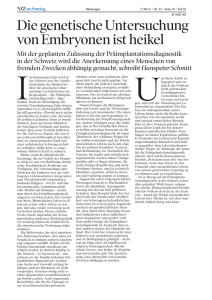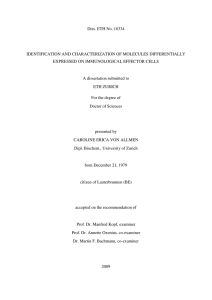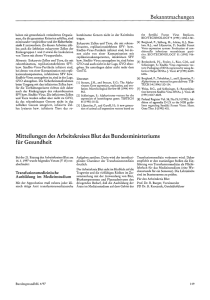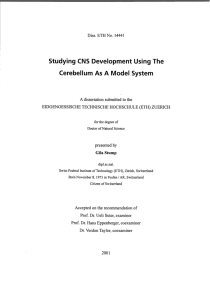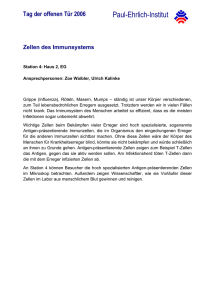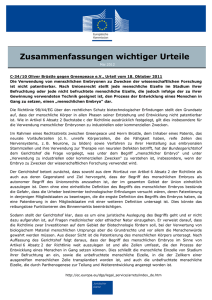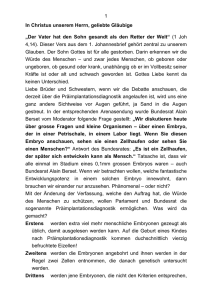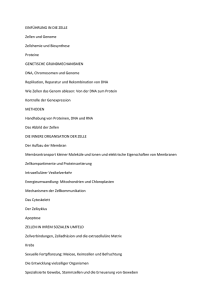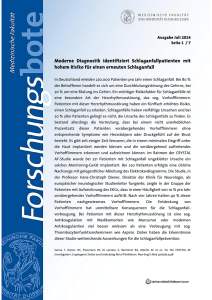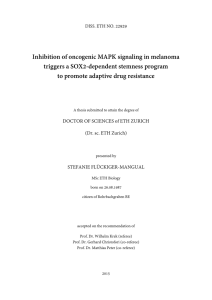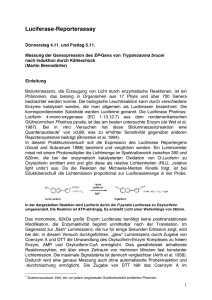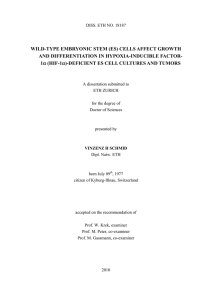Abstract - ETH E
Werbung
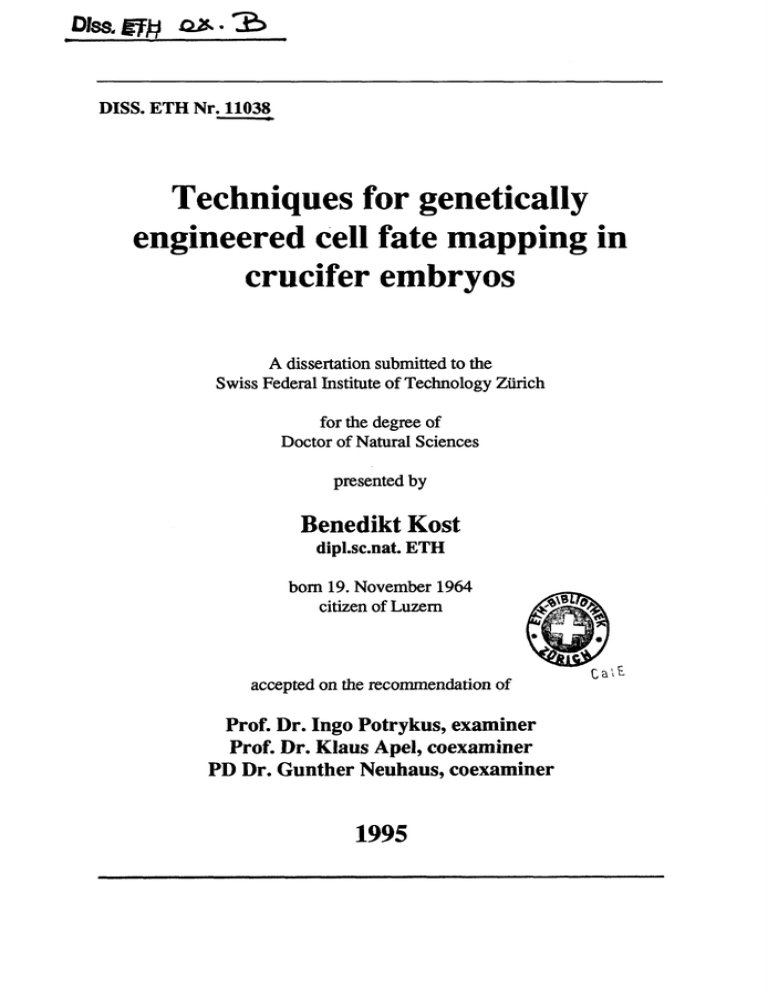
Dfs&gflj aa-lfe DISS. ETHNr. 11038 Techniques for genetically engineered cell fate mapping in crucifer embryos A dissertation submitted to the Swiss Federal Institute of Technology Zurich for the degree of Doctor of Natural Sciences presented by Benedikt Kost dipl.sc.nat. ETH born 19. November 1964 citizen of Luzern accepted on the recommendation of Ingo Potrykus, examiner Prof. Dr. Klaus Apel, coexaminer PD Dr. Gunther Neuhaus, coexaminer Prof. Dr. 1995 Ca'.E 1. Summary 1. 1 Summary have been established for Techniques zygotic the crucifer embryos. 1) The assay used to has been set up that is sensitive in (LUC) activity Arabidopsis of earlier with (Kost et single plant embryos. 3) al. 1992, and accelerators has been microinjection system and obtained into given at A flexible, scan CCD In the transgenic the and the as well as firefly of system luciferase had been established similar culture system a juncea (Indian mustard) two different particle of genes encoding visible analysed. was improved using and the protoplasts of DNA as a model juncea embryos. All results of the techniques listed above the work that is summarised in submitted for were technique The tobacco application into publication. The references paragraph. (Charge Coupled Device) camera based on has been a set liquid nitrogen cooled, up, that chemiluminescence system and the firefly luciferase (LUC) tobacco cells transiently expressing no effect on employed for fluorescence) imaging. or as a screenable marker, the firefly luciferase gene stably transformed calli, regenerated shoots, plantlets could be monitored in vivo with be can slow direct gene transfer. Bioluminescence produced by tobacco lines have been from of camera by microprojectile bombardment resulting expression comparatively inexpensive system single in excised for gene transfer into cells of young excised A. thaliana and B. globular development the end of each emitted from presented thesis, Gene transfer following paragraphs camera video a globular stage is described for Brassica quantitative low-light (bioluminescence, Using this and microscopical detection Additionally, manuscripts describing here. each of the three optimised excised at the cells has been to mapping 2) A culture system that allows in vitro development techniques optimised plant concerning presented was early heart-shaped B. juncea embryos using applied was cell fate non-destructively analyse expression cells and multicellular sectors single markers in for appendix). tested. were globular, transition are see Two alternative embryos crucifer are cells. embryos thaliana cells enough improved performance an plant luciferase gene (Luc) in firefly genetically engineered the and Tl (Luc) seedlings viability of the analysed material. The pattern of light emission from sections through Lwc-expressing leaves and bioluminescent single protoplasts isolated from such leaves used to detect in vivo LUC emitted from Luc-expressing substrate solutions and activity was tobacco determining were imaged microscopically. also The assay optimised by quantifying bioluminescence protoplasts the kinetics of and leaves incubated in different light emission during incubation in the substrate solution. ("Non-destructive using I. a detection cooled, slow scan of firefly luciferase (LUC) activity CCD camera and an optimised assay." Potrykus and G. Neuhaus; "The Plant Journal", in press) in single plant B. Kost, M. cells Schnorf, 1. 2 Summary single cells of A method has been established that allows the transfer of genes into globular stage zygotic excised cells was (EMB) or at followed later stages, which suspensor) solid and both a particle transient (PIG) and 30 \xm are deleterious effects in vitro on development of in receiving survive can particular genetically marked cells. embryonic (Luc) luciferase gene a new sectors, we acceleration (|$- had no sectors were normal resume information about the To be able to follow tried to identify reporter be non-destructively (which encodes GUS), Preliminary resulted in transient GUS particle and provided data has shown that be detected in bombarded can particle on characterising early B. juncea embryogenesis. genes that, in contrast to the uidA gene assayed microprojectile to optimal conditions under The examination of these sectors has cell division patterns the surface of embryogenesis. Multicellular GUS expressing obtained, showing that cells development. on early heart-shaped embryos using visible markers. For both glucuronidase) expression. Bombarding embryos the accessible shooting conditions have been optimised based devices the proper without long (embryo grow globular the The smallest embryos. grown embryos freely at micro-targeting particle accelerator a encoding of genes are transition and globular, at inflow gun expression and embedding Shooting bombardment. fully than 20 cells. The comprised of less and defined culture medium simple juncea embryos, excised B. into mature, cultured efficiently be without medium zygotic which on A embryogenesis. develop normally can are juncea embryos. The fate of single, genetically marked in vitro designed has been embryos during B. can expression of the without affecting embryos firefly their viability. ("Transient marker gene expression during zygotic in vitro embryogenesis ofBrassica juncea (Indian mustard) following particle bombardment." B. Kost, N. Leduc, C. Sautter, I. Potrykus and G. Neuhaus; submitted to "Planta") An efficient system has been established that allows well controlled DNA into tobacco analysis of targeted mesophyll protoplasts transient cells or as well as with stable partially regenerated expression of cell walls and injected reporter genes derived clones. The system represents an techniques. Protoplasts solidified with agarose were alginate. or DNA coinjecting FITC-dextrane and aimed procedure was optimised compartment. Cells were for found immobilised in at efficient to microinjection the cytoplasm delivery be at the of very thin a was of days by incubating injection solution was in particular to microinjection monitored optimal stage for into solution microinjection kept at coinjection of FITC-dextraiie and pSH1913, into 20-40 cells. a this about 24 this stage them at 4*C in the dark. Within 1 hour successful routinely possible by injection of target cells. The injection study layer of medium routinely hours after immobilisation in solid medium. Embedded cells could be for up to 4 subsequent effective tool parameters important for the successful transformation of plant cells by and other microinjection delivery Following cytoplasmic plasmid containing the neo (neomycin 1. Summary 3 phosphotransferase II) recovered gene, stably transformed, paromomycin through selection. Transgenic tobacco lines has clones. Injection mg/ml have been tested. With 1 per solutions successfully injected embedded protoplasts containing pSHI913 cell at determined was 4°C before of resistant clones obtained per pattern and the location of injected cells of injected dextrane and 1 developed Transient integration that of the injection of the of DNA found Protoplasts recorded were to 1 of reduce the percentage immobilised above by Polaroid photography. firefly injected average about 20% of the on roughly 50% of these calli luciferase gene (Luc) pAMLwc. Approximately expressed the this time at was higher. Incubation possible. Following cytoplasmic coinjection was into microcalli and 24 hours after alive cells mg/ml plasmid expression was or a grid The fate cells could be observed. Isolation and individual culture of clones particular targeted derived from be about 3.5 times to cell. |ig/ml DNA the percentage of resistant clones microinjection injected been established from such concentration of either 50 at a mg/ml plasmid resistant clones could be Luc gene was were essentially cells non-destructively analysed 50% of the all targeted stably transformed. injected transiently. Apparently, genes occurred in of FITC- cells that stable were genomic transiently expressing cells developed into clones. ("High-efficiency transient and stable transformation by optimised DNA microinjection protoplasts." into tobacco Potrykus B. Kost, A. Galli, I. and G. Neuhaus; submitted to "Journal of Experimental Botany ") Genes encoding particular target alginate on cells within excised medium with plasmid DNA of appeared microinjected zygotic a tiny under optimal A. thaliana and B. amount visual control into juncea embryos. The of culture medium solidified with the top of solid basis medium. The type and concentration of the optimised delivery were have been immobilised in embryos been visible markers for firm injection capillaries. solution into be difficult development of however, could targeted Microinjection cells had no targeted embryos. Transient never be observed. and easy FTTC-dextrane in order to be able to monitor the injection to embryo immobilisation was delivery was penetration with the of injection solution. Successful possible stable embedding coinjected together in many cases, deleterious effects or of the alginate has on although it the further in vitro expression of injected genes, 2. Zusammenfassung 2. 4 Zusammenfassung Um das Schicksal einzelner, genetisch markierter Zellen in zygotischen Embryonen KreuzblMern wahrend der in vitro engineered cell fate fur den Nachweis wurde optimiert mapping"), LUC von und ein Entwicklung verfolgen folgende Techniken wurden Videokamera-System wurde in lebenden Pflanzenzellen aufgebaut, mit dessen Hilfe LUC Aktivitat in einzelnen Pflanzenzellen detektiert werden kann. 2) Ein Entwicklung die in vitro bereits friiher worden (Kost Arbeit wird ein ahnliches, verbessertes Embryonen junger Zellen Embryonen Entwicklungsstadium die daraus von Appendix). In der vorliegenden Kreuzbliidern wurden ausgetestet. Der Gentransfer in resultierende Expression Pflanzenzellen wurde am optimiert Markergenen (Gene, gemacht werden kann) analysiert sowie erste Die und deren in einzelnen Zellen Die Technik der DNA Anwendungen Manuskripte Ergebnisse prasentiert werden, sind. sichtbaren von wurde Mikroinjektion in auf juncea Embryonen angewandt. Die Entwicklung der beschrieben. Zusatzlich wurden zusammengefasst Mikroprojektilen Modellsystem "Tabak Protoplasten" verbessert und A. thaliana und B. aufgezaWten Techniken mit sichtbar ist oder und multizellularen Sektoren wurde Abschnittes al. 1992, Kultursystem fur Brassica juncea (Indischer Senf) Bombardierung durch Expression in lebenden Zellen globulare et ist juncea Embryonen im globularen, intermediaren und herzfQrmigen B. von das 3) Zwei alternative Methoden fur den Gentransfer in Zellen beschrieben. isolierter Kultursystem, globularen Arabidopsis thaliana Embryonen erlaubt, von ausgearbeitet 1) Die Methode entwickelt: ("Firefly" Luciferase) Aktivitat ("genetically konnen zu von die in zur jedem sind in der Publication der drei vorliegenden eingereicht, Arbeit in denen die nachfolgenden Abschnitte entsprechenden Literaturhinweise sind am Ende jedes aufgefuhrt. Basierend auf einer Stickstoff gekiihlten, langsam auslesenden CCD (Charge Coupled Device) Kamera wurde ein flexibles und vergleichsweise kostengiinstiges System aufgebaut, mit dem schwache Lichtemissionen (Biolumineszenz, Chemilumineszenz oder Fluoreszenz) quantitativ detektiert werden konnen. Dieses Kamerasystem und das "Firefly" Luciferase Gen transgene Aufnahmen Tabaklinien von durch Gentransfer regenerierten Sprossen, negative Auswirkungen werden. Schnitte durch Protoplasten direkten herzustellen. wurden von von Keimlingen auf die Vitalitat des untersuchten Materials Lwc-exprimierende ebenfalls in Biolumineszenz konnte sogar durch das fur den Nachweis Pflanzchen und Tl Blatter sowie Substratlosung Mikroskop aus um Biolumineszenz einzelnen, transient Luc-exprimierenden Tabakzellen sowie transformierten Kalli, ohne (Luc) als "selektierbarer" Marker wurden verwendet, stabil konnten gemacht solchen Blattern isolierte inkubiert Die ausgesandte detektiert werden. Um die Methode LUC Aktivitat in Pflanzenzellen zu optimieren, wurde die von Luc-exprimierenden Tabakbl&ttern und -protoplasten in verschiedenen Substratl&sungen 2. Zusammenfassung 5 prcxiuzierte Biolumineszenz Inkubation in gemessen und die Kinetik der Substratldsung Lichtproduktion wahrend bestimmt ("Non-destructive detection of firefly luciferase (LUC) activity using I. a cooled, slow CCD scan der and camera an single plant in cells optimised assay." B. Kost, M. Schnorf, Potrykus and G. Neuhaus; "The Plant Journal", in press) Eine Methode wurde ausgearbeitet, Mikroprojektilen in einzelne Zellen wurde zu ausgewachsenen, auf dem sich von weniger als 20 Zellen. Die festem Medium Mikroprojektilen. Embryonen targeting" und frei waren Verwendung Partikel lang (Embryo ii.m Embryonen wuchsen Der Beschuss unter 30 waren von zuganglich "particle fuhrte zu Markergenen. Basierend auf transienter GUS Schiessparameter beide Partikelbeschuss Auswirkung fur von Partikel Embryonen auf die in vitro unter zum und bestanden Bombardierung die und friihen inflow gun (PIG)" transienter Expression herzformigen oder eines "micro- Beschleunigungsapparate sichtbaren von (P-Glukuronidase) Expression optimierten Bedingungen wurden die optimiert. hatte keine subepidermale Zellteilungsmuster zeigen, dass Zellen den Empfang eines Nachweis sichtbare von GUS-Aktivitat als Markergene Pflanzengewebe analysiert Zellschicht ausdehnten, liessen typisch zu, die Partikels sind fur die Kreuzblutler war UidA fur die untersuchten wurden werden kann. getestet, Embryoentwicklung. Embryonen lethal. deren zu der von Schliisse auf die neue Expression Vorlaufige Ergebnisse zeigen, ist, "Firefly" Luciferase (LUC) Aktivitat in bombardierten Embryonen ohne deren Vitalitat Der negativen iiberleben und sich nachher normal entwickeln konnen. Sektoren, die sich in die mit Embryoentwicklung. Multizellulare, GUS-exprimierende Sektoren wurden beobachtet, die Epidermis voll auf der Oberflache Einbettung fur (EMB) die effizient Embryonen, globularen, intermediaren einer Beschleunigers ohne normal Suspensor) ohne zu wahrend der normalen globulare B. juncea Embryonen reifen Stadium entwickeln. Die kleinsten kultiviert werden konnten, aus genetisch markierten Zellen Ein einfaches und definiertes Kulturmedium verfolgen. zusammengestellt, erlaubt, Gene durch Bombardierung mit es globularen, zygotischen B. juncea Embryonen von transferieren und das Schicksal der Embryoentwicklung die in dass zu Der Andere lebendem es moglich detektieren, vermindern. ("Transient marker gene expression during zygotic embryogenesis of Brassica in vitro juncea (Indian mustard) following particle bombardment." B. Kost, N. Leduc, C. Sautter, I. Potrykus and G. Neuhaus; submitted to "Planta") Ein effizientes System wurde entwickelt, Tabakprotoplasten mit nachfolgende Analyse bestimmten Zielzellen Systems von teilweise das gut kontrollierbare DNA regenerierten transienter und stabiler beziehungsweise Zellwanden zulasst, sowie Expression injizierter Markergene in die in daraus entstandenen Klonen. Mit Hilfe dieses konnen Parameter ausgetestet werden, die fur die Pflanzenzellen durch DNA Mikroinjektion erfolgreiche Transformation Mikroinjektion und andere Techniken wichtig sind. Die 2. Zusammenfassung Protoplasten 6 wurden routinemassig durch ausgewShlten immobilisiert. Koinjektion Zellen Einspritzen effizientes diinnen, durch Zugabe einer Mediumschicht verfestigten, von in 24 Stunden nach der gezielt. DNA Alginat oder Agarose Mikroinjektion FITC-Dextran uberwacht und in das von Der gesamte Immobilisierung Injektionsvorgang wurde in dieses InjektionslQsung von Die von Zytoplasma im Hinblick auf Kompartiment optimiert. Ungefahr verfestigtem in wurde Medium waren die Zellen in einem optimalen Stadium fur die Mikroinjektion. Eingebettete Zellen konnten durch Inkubation in volliger Dunkelheit einer Stunde war es bei 4°C bis zu 4 in diesem Stadium konserviert werden. In mdglich, erfolgreich Injektionslosung zytoplasmatischer Koinjektion Nach Tage (Neomyzin Phosphotransferase TI) in 20-40 Zellen pSHT913 FTTC-Dextran und von zu spritzen. mit dem Gen konnten stabil transformierte, neo Paromomyzin resistente Klone durch Selektion isoliert werden. Eine Anzahl transgener Tabaklinien wurde von solchen Klonen regeneriert. Injektionslosungen, die entweder 50 |xg/ml oder mg/ml pSHI913 enthielten, wurden getestet. Die erfolgreiche Injektionen Inkubation von ungefahr war Anzahl resistenter Klone auf 100 3.5x hoher mit 1 eingebetteten Zellen bei 4°C vor Reduktion der Anzahl resistenter Klone auf 100 der mg/ml Fotografien festgehalten. verfolgt konnte werden. Es isolierten und einzeln mg/ml Dextran und 1 aller zu injizierter Zellen diesem kultivieren. Nach zu Mikrokalli und Expression des injizierter injizierten Zellen Zellen wurde injizierter entstandene Klone zytoplasmatischer Koinjektion etwa 50% Zellen zu FTTC- von ungefahr 20% der Mikrokalli waren 'Firefly" Luciferase Gens (Luc) stabil wurde 24 erfolgreich injizierten Zellen, die Zeitpunkt uberlebt hatten, exprimierten das Luc Gen transient. Stabile, genomische Integration der injizierten Gene transient exprimierenden Zellen, die sich ("High-efficiency into tobacco einer Etwas 50% der Injektion analysiert. Stunden nach der zu aus zu erfolgreiche Injektionen. Protoplasten Das Schicksal ganz bestimmter moglich, ftihrte Plasmid DNA entwickelten sich im Durchschnitt transformiert. Transiente bis war Plasmid DNA. Die Mikroinjektion wurden fiber einem Gittermuster immobilisiert und die Position auf Polaroid 1 transient and stable protoplasts." B. Kost, A. zu erfolgte offensichtlich grundsatzlich in alien Mikrokalli weiter entwickelten. transformation by optimised DNA microinjection Galli, I. Potrykus and G. Neuhaus; submitted to "Journal of Experimental Botany ") Sichtbare Markergene wurden unter isolierten zygotischen A. thaliana und B. wurden in immobilisiert. einer Typ sehr kleinen optimaler optischer Kontrolle Menge juncea Embryonen injizierL mit Alginat verfestigtem und Konzentration des verwendeten Embryo Immobilisierung und Injektionskapillaren optimiert. problemlose Penetration Um das konnen, wurde FITC-Dextran Einspritzen zusammen regelm&ssig Schwierigkeiten auftraten, in bestimmte Zellen in von Alginats des Die Embryonen Kulturmedium wurde auf stabile Einbettungsmediums Injektionslosung uberwachen mit der Plasmid DNA konnte in vielen Fallen koinjiziert. mit zu Obwohl Injektionslosung in 2. Zusammenfassung Embryozellen Auswirkungen der 7 eingespritzt werden. auf die in vitro injizierten Markergene Die Mikroinjektion Embryoentwicklung. wurde allerdings keine negativen Transiente oder stabile Expression nie beobachtet. hatte
